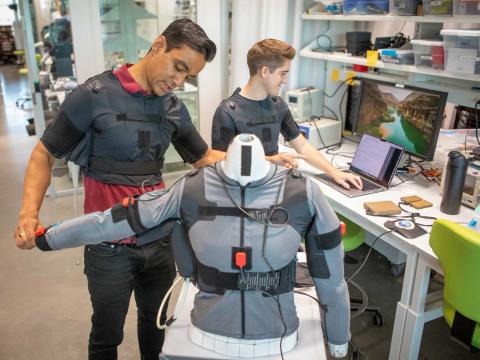NSF Launches Artificial Intelligence Research Resource Pilot
Today, the U.S. National Science Foundation (NSF) and 10 collaborating agencies launched the National Artificial Intelligence Research Resource (NAIRR) pilot, which will provide access to advanced computing, datasets, models, software, training and user support to U.S.-based researchers and educators.
By connecting researchers and educators with the resources needed to support their work, the NAIRR pilot is expected to power innovative AI research, maintain U.S. competitiveness and inform the design of the full NAIRR ecosystem. The pilot phase, which will last two years, is a proof of concept to ignite the level of investment needed to realize the full NAIRR vision, according to an embargoed press release provided to journalists yesterday.
According to the press release, the pilot’s operations will be organized into four focus areas:
- NAIRR Open will enable open AI research through access to diverse AI resources via the NAIRR Pilot Portal and coordinated allocations.
- NAIRR Secure, co-led by the National Institute of Health and the Department of Energy, will enable AI research requiring privacy and security-preserving resources and will assemble exemplar privacy preserving resources.
- NAIRR Software will facilitate and investigate interoperable use of AI software, platforms, tools and services for NAIRR pilot resources.
- NAIRR Classroom will reach new communities through education, training, user support and outreach.
During an embargoed online briefing with reporters, Sethuraman Panchanathan, NSF director, said that artificial intelligence, or AI, will make possible four other AIs: advancing ideas, activating innovation, accessibility and inspiration, and accessible infrastructure. “With NAIRR, we will move fast and build things,” he said.
“A National AI Research Resource, simply put, has the potential to change the trajectory of our country’s approach to AI,” Panchanathan told journalists. "It will lead the way for a healthy, trustworthy, U.S. AI ecosystem.”
The NSF director also pointed out that his organization, the lead agency for NAIRR, launched the pilot just 90 days after the release of White House Executive Order 14110 calling for the safe, secure and trustworthy development and use of AI technologies.
Panchanathan also suggested the breadth of partners working together on the NAIRR pilot underscores the urgency of developing the pilot for the future of AI in the United States. “By investing in AI research through the NAIRR pilot, the United States unleashes discovery and impact and bolsters its global competitiveness. To continue leading in AI research and development, we must create opportunities across the country to advance AI innovation and strengthen educational opportunities, empowering the nation to shape international standards and igniting economic growth.”
The embargoed briefing with reporters also included Katie Antypas, director of the NSF Office of Advanced Cyberinfrastructure; Michael Littman, director, of NSF’s Division of Information and Intelligent Systems; and Tess deBlanc-Knowles, NSF special assistant to the director for AI.
The early goals for NSF and its various partners will include determining the design of the NAIRR itself. Initially NAIRR will provide computing power from supercomputers provided by NSF and the Department of Energy, but partners will contribute resources with a variety of interfaces that will be integrated in the coming months. At the time of the press briefing, 25 partners were involved, but that number is expected to grow.
Although trustworthy AI is a primary focus, Littman noted that trustworthiness is a relatively new concept for AI systems and that the meaning of “trustworthy” in that context is still being hashed out. “I think the reason that this is important is that there’s a gap between the way that machine learning systems work out of the box and the way that we want to use them in society-relevant use cases. These models, or these systems, these algorithms, are really trained to mimic the data that they’re trained on, but that’s not great when the data is loaded up with biases, or private information, errors, socially unacceptable language, many other things,” Littman said. So, getting systems to do what we actually want them to do requires new advances in how they’re trained, how data’s collected, how data is vetted and lots of other things.”
One of the first steps will be a joint workshop with personnel from the National Institute of Standards and Technology (NIST) to “think through the ways in which the NAIRR can support moving forward on trustworthy AI, building in best practices for AI governance,” deBlanc-Knowles reported.

A National AI Research Resource, simply put, has the potential to change the trajectory of our country’s approach to AI. It will lead the way for a healthy, trustworthy, U.S. AI ecosystem.
Also upcoming will be a survey in the form of a request for information (RFI), Antypas said. “A key element of this launch that will be open tomorrow is a survey that will be coming out as an RFI that I call a lightweight survey for the researcher and educator community to seek their feedback and their priority use cases for the NAIRR pilot, and so we are hoping to reach thousands of users, of researchers and students that will provide us some of that immediate input to help us really think about those priority areas and how we go forward in designing the pilot from here on out.”
Antypas told reporters that a NAIRR pilot steering committee made up of all the government partners has been meeting frequently to prepare for the launch. Additionally, a number of interagency working groups are working on AI best practices.
Industry partners so far include a wide array of companies big and small, such as Google, Hewlett Packard, Amazon Web Services, IBM, Meta, Microsoft, NVIDIA, OpenAI and Palantir.
Government partners include:
- U.S. Defense Department
- Defense Advanced Research Projects Agency
- Department of Energy
- Department of Veterans Affairs
- NASA
- National Institutes of Health
- NIST
- National Oceanic and Atmospheric Administration
- Patent and Trade Office





Comments